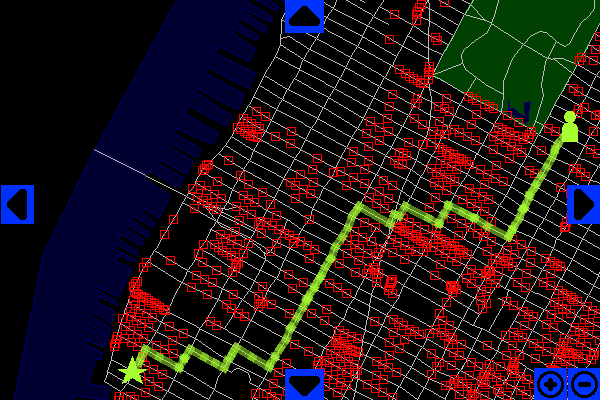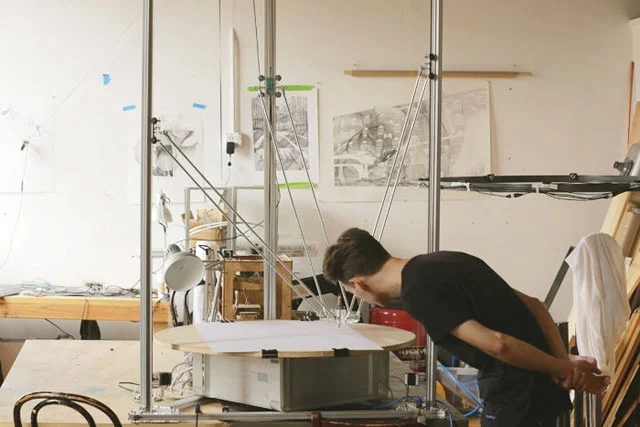Circles Mirror
Bridging the gap between the physical and the digital, Daniel Rozin creates “mirrors” out materials other than glass. A combination of mechanics, motors, video cameras, and algorithms these mirrors create real-time images of the people standing in front of them without using the refraction of light on glass, but rather playing with the concept of pixels on a screen. As the website Guilty People puts it,
“What Daniel does is define unusual elements to take the place of these pixels.”
In the particular piece, Circles Mirror, the image is created as a combination of the graphic designs on the disks and an algorithm that changes their positioning. The disks are controlled by motors, that are then controlled by a video camera that is facing out of the piece and at the viewer. When the image in front of the video camera changes, the circles on the piece change positioning to reflect the different facets of light and dark that are shown within the video image. Each circle has a unique graphic design that is equal parts light and dark, and due to their overlapping nature, each circle only shows the one of either color. Altogether, the circles create an image of light and dark that is the mirror image of the person and movements that are standing in front of the piece. Circle Mirror is a combination of digital interfacing and physical elements that creates both a beautiful image, and fun interaction for the viewer of the piece.
Created in conjunction with the other Daniel Rozin’s other mechanical mirrors, this piece is one of many intended to explore the intersection between physical art and digital art. Using a combination of physical and digital elements, Circles Mirror, creates a dialogue about what should be considered digital artwork. Though the piece consists mostly of physical elements, it becomes nothing without the video camera or algorithm that tells the motors when to turn. Without the digital component, the physical components lose their function and the work of art ceases to have its original meaning. It then exists in somewhere between digital and physical artwork, bridging the gap between what each of the mediums consists of. Additionally, Circles Mirror, is the first of Daniel Rozin’s work to include some of his graphic design work. Each of the circles has one of his unique designs to printed on them, and it is the difference in their patterns and shades that creates the light and dark image that is shown the viewers of the piece. Considering that the motors must turn these disks in the right fashion to create the image being shown, even the designs on the disks serve as a bridge between computer generated artwork and more traditional mediums of art, such as print.
Another piece that attempts to bridge the digital and physical art spaces is entitled Untitled 5 by Camille Utterback. Similarly, to the Daniel Rozin’s piece, Untitled 5 tracks the viewers of the artwork within the space and translates that into a visual image. However, instead of displaying the image as a reflection, the piece shows the movement of participants more like brush strokes on a canvas. Unlike Circles Mirror, this allows Untitled 5 to bridge time, by showing the movements of multiple people on the canvas at once. Where Circles Mirror reacts in real time, Untitled 5 captures its viewers at a slower pace, overlapping their separate interactions. Though it is a completely digital art piece, it represents the more traditional art form of paintings, seeking to bridge the gap between what people consider physical and digital artwork. Combining the real human element with the “paint” on a digital canvas, conceptualizes the real-world for the viewers in an interesting format while also serving to challenge art world norms.
In a more fantastical approach to bridging this gap between physical and digital art comes the work of Theo Jansen in his collection entitled Strandbeest. A collection of robots, made from online pipes and pulleys, Jansen explores the literal physical interaction between the digital and the physical, much like in Daniel Rozin’s work. However, Jansen creates these robots to explore the notions of evolution, rather than to challenge the art world and its framework. Though his pieces reflect that robotic art is maybe the most sophisticated bridge between physical and digital components, it also generates a dialogue that maybe the next step in evolution is not related to human life, but rather the digital one. As these creatures have no predators and no need for sustenance, they potentially can live forever roaming the earth.
Though Circles Mirror may not be a physical mirror, it combines digital and physical elements to react in real time just as a mirror would. It seeks to reframe the definitions of digital artwork versus physical artwork, as without both the piece would not exist. It seeks to uproot one’s idea of what physical and digital art can encompass and replace it with something fantastical. By generating discussions on what is possible with the fusion of two mediums, instead of merely sticking with one medium Daniel Rozin opens up the art world and artists to appreciate and try more experimental pieces. His work is both fantastical and real, making it something most definitely worth talking about.
Sources:
http://www.guiltypeople.org/mechanical-mirrors-of-daniel-rozin/
http://mymodernmet.com/awesome-and-magical-i-mean/
http://www.smoothware.com/danny/circlesmirror.html
https://www.youtube.com/watch?v=lP5yeOMlsYQ
http://www.digiart21.org/art/strandbeest
http://www.digiart21.org/art/untitled-5?rq=untitled%205







